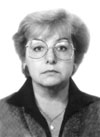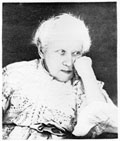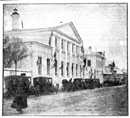|
Since 1994 Nina Kovaleva has been published in the mass media. " Archival (and from the first view, in many respects an antediluvian) material became an indispensable help in working out a law about charity, which I was working at when I was an assistant deputy in the Moscow City Duma. But frankly speaking, other tendency in work seemed to me more perspective for the revival of the traditions in this sphere - it was holding of many-sided meetings in the refuge for old Muscovites in the Bolshaya Ordinka street. The press representatives, government officials, businessmen and the wards of the refuge for old Muscovites held a detailed and specific conversation in favor of all people who bestow charity". The editors of the magazine and Nina Kovaleva are planning to continue the rubric - and we hope that you, our readers, will reveal for yourself new, wrongly forgotten names in the history of Russian charity. A talent of mercyNina Kovaleva
I must confess that nothing of this kind yet happens with a phenomenon called charity. It is likely to be so because the introduction of "new" for Russia forms of aid for indigents - either from ignorance or from lack of skill - is accompanied solely by foreign wrapping. The result is coldness of the society to any undertakings of such a kind, and in some sections of society - even denial. There is a fine example of it - it is a so-called "Austrian village", widely advertised several years ago as an up-to-date way of accommodating orphans. Small houses and common household buildings, grouped on a common ground; in each of them lives a small group of children in the charge of a "mother"-governess - in such way at the end of the twentieth century Russia joined to the modern achievements of social pedagogics - orphans need a family, even if it is artificial. But it turned out that all this already existed in the city of Serpukhov at the beginning of the twentieth century. In her country estate Alexandra Ivanovna Konshina established a similar institution - an asylum for bringing up and educating children. Such was her idea - children should be taken care of in a way as close to family conditions as possible. An experience of an asylum organization, acquired by Alexandra Ivanovna Konshina, was suitably followed by her executors who, according to her will should have used 1 million roubles for innovation of the country estate to meet children's needs. The same small houses as mentioned were to be built: a group of children of both sexes and of different ages with a governess, forming something like a single family, were to live in each of them. Besides, servants for cooking were supposed to live in each house. Stable, pigsty and poultry-yard were situated separately. An area of fifty nine dessiatinas or 600000 square meters with a flood plain gave an excellent opportunity for farm work. Already during the life of Alexandra Ivanovna Konshina the manor-house with a green-house were rebuilt so that grand meetings and literary soirees could be held in the most solemn halls. There was an electric lighting in the indoors, and the electric power station was set up in the handicraft classes of the own professional technical school. The project was entirely realized after Konshina's death. But these are not all the amazing things of Koshina's heritage. There is also a so-called House of Mother and child, which now, in the XXI century is perceived as a social science fiction. The purpose of this establishment was to help needy women in the most difficult moment of their lives - during the deliveries. One or two months before the delivery they could come to the ward for expectant mothers and were completely supported there together with their children who were under eight. For this purpose in the House there were a day nursery and a kindergarten. Helping about the house women before the delivery were always under observation of medical attendants. After the delivery a mother could stay, if she likes it, in charge of physicians for two more months. During this time she was taught a right baby-minding; her baby was set apart which was an expensive innovation. On completion of the period of living in the House "...A Council of trustees was to consider carefully the conditions of a woman life and ,if possible, to render her help on leaving the House". Baby-orphans, left without a mother, also were under the protection of a Council of trustees. Thoroughly calculated sums of money, allotted by Alexandra Ivanovna Konshina for charitable projects, once more confirm the seriousness of her intentions and in some way her professional approach. Everything was counted - both ward's tenure in the institution, and necessary medical supplies, equipment and outfit for an appropriate establishment, and an appropriate infrastructure. The capital intended for the House of a mother and a child amounted to eight hundred thousand rubles. Considerable, even huge sums of money Alexandra Ivanovna Konshina sent as a pecuniary aid of the most wretched. Women and children are vulnerable in any society, and benefactress Konshina didn't forget about it. However, responding to the demands of wartime, the prevailing amount of funds she gave to wounded and invalid soldiers, continuing to stipulate that the money was intended for low rank soldiers. At the beginning of the World War I a challenge not only to the charity of the XXth century but to the charity of remote future was thrown down on behalf of Alexandra Ivanovna Konshina. The House of care for incurable soldiers, established by her and perfected by the executors after her death, exceeds by far many similar modern institutions. Yes, in Russia really existed such form of help to people who till the end of their days were doomed to need care. But it wasn't called a modern word "hospice", but a simpler word - alms-house, or a charity house. As the patients of such institutions needed medical care, alms-houses quite often had an appropriate staff, equipment and physicians. The latter were chosen by a competition and were famous specialists. But Konshina's donation to soldiers was a really unique one. Several three-storey brick houses equipped by elevators for transportation of the patients straight in their beds, and by hoists for rendering the food straight to the floors. Public gardens were planted on the territory; service premises were concentrated on a separately located household yard. Medical care for wards under special care was provided in a hospital with two sections: surgical and therapeutic ones. In addition to the conventional equipment the hospital included a gymnasium and consulting rooms of different types: X-ray, mechanical-therapeutic (according to the terms of that time), electrotherapy, phototherapy and hydropathic treatment. For psychological relief there were special workshops situated on ground floors: joiner's shop, carpenter's workshop, bookbinder's shop and shoe shop. It was, of course, a suitable shelter for those motherland defenders who had been violently maimed by the war. Considerable, for those times, sums of money were appropriated by the benefactress - one million two hundred thousand rubles. Moreover, in her will Alexandra Ivanovna Konshina left two hundred thousand roubles for establishing an additional section at the city clinic at Kanatchikov dacha, as by that time Alexseevsky mental hospital was already overcrowded with arriving from the front line soldiers who for the first time faced all the horrors of war, marking the arrival of a new era, an epoch of "civilized states". Not all of her donations were so large as the above mentioned ones. Nevertheless, even one of those "medium-size" donations was enough to arouse gratitude in her contemporaries and to remain in the in memory of progeny. Thus, a shelter for wounded the laying of which was started on July 14,1915 in Bolshoi Novo-Peskov side street in Moscow, could be considered a "modest" deed of Konshina in comparison with other ones. The shelter was built by the First Presnensky destitute guardianship on the donated by Konshina one hundred fifty thousand rubles. A three-storey brick building was to be built, comprising thirty two rooms flats for maimed soldiers and their families. Both a workshop for invalids and a school for their children were envisaged there; it was rather natural and went without saying: a work should be given to those who are able to work, and an opportunity to get education and acquire a profession should be given to those who were still to gain a foothold in life. After Konshina's death, in spite of the difficulties of a wartime, the plans of the realization of Konshina's donation became true very quickly (A.F.Deruzhinsky and N.A.Tsvetkov, executors of the deceased played in this case a key role). As early as in four months after Konshina's death, namely on February 17, 1915, the Moscow Duma decided to accept the donation and undertake obligations to execute the donor's will. Thus, in the September number of the "Moscow City Duma news" for the year of 1916 it was stated: "...the Konshinsky charity House, a hospital in Bolshoi Yakimanka street and a mental hospital on Kanatchikova dacha are under construction and in the near future will be handed over to the jurisdiction of the city". It should be mentioned that the donation, made for the victims of a new terrible war, proved to be the most timely response to the problems of the Russian society. Until now the story mainly concerned the continuation of the Konshina's deed after her death or, figuratively speaking, her "life" after the death. But in a real life the widow of the representative of one of the most famous dynasty in Russia had time to attach this name a new coloring, having not only attached the Konshins to the assembly of factory-owners, bankers, owners of stud-farms, elite motoring-lovers, and thus socially ennobling this merchant family. The wartime of 1914; beginning of military operations. Newspapers are full of reports of sick quarters and hospitals openings, of sending more and more medical units to the front, and of arriving of trains with wounded. At this moment ninety-year-old Konshina is engaged with equipment of the health centre for recovering soldiers at her dacha in Petrovsky park. Later she will leave it to Moscow Social office, together with three hundred thousand rubles to put the dacha in proper order.
To the story about good deeds of one of the greatest Russian philanthropists we should add some facts about herself. Sasha Ignatova, a daughter of a Serpukhovsky second guild merchant, couldn't boast of a particular progressive breeding and surroundings, so she happily married Ivan Nikolaevich Konshin, a very well-to-do factory-owner. The Konshin family goes back to the Serpukhovsky craftsmen and has been mentioned as Konsha since the middle of the XVI century. Linen and cotton manufacture, conducted by the Konshins, enlarged step by step and by the beginning of war with Napoleon Nikolai Maksimovich Konshin established his own factory. After his death Marpha Filippovna, his wife, took her stand at the head of the business. She had to control the factories equipped with almost 2.5 thousand machine-tools, where almost 3 thousand workers worked. In spite of the fact that under her woman guidance the factories worked duly, in the course of time she shared the property between her sons. Ivan Nikolaevich, one of the brothers, presided himself in the Staraya Miza estate. After successful bargains on cotton purchase before the Civil war in the USA he greatly increased his capital, but an essential expansion of production didn't follow. In 1898, dying, he left Alexandra Ivanovna Konshina, his wife, a considerable fortune. However, she didn't want to continue her husband's business, liquidated the enterprises and, according to her contemporaries, " entirely devoted herself to the cause of mercy". Alexandra Konshina wasn't put to test by indigency, directing towards a search of social justice; she didn't have a particularly personal motive (at least, an open one) for such generosity. May be, it is just a talent, a talent of mercy. Not a contemplative, salving and delighting your own soul mercy, but an effective mercy, making your soul work. |
 We present you the author: Nina Mihailovna Kovaleva - - a permanent editor responsible for the rubric "Women in Russian charity" (the materials are in the magazine "Woman Plus...", N 1,2/2001). A Chemical Engineer. During the perestroika (reorganization), irrespective of the author's will, she had enough free time, which was used in a new kind of activity. Reconstruction of a family tree (her husband is a Muscovite in the seventh generation) led her to charity, as her husband's ancestors, brothers Solodovnikovs and their nephew and spiritual heir Ivan Grigorievich Prostiakov, deeply respected among the Moscow merchants, made an important contribution to the "cause of mercy". This subject absorbed the author so much that the history of Russian charity became her main professional interest.
We present you the author: Nina Mihailovna Kovaleva - - a permanent editor responsible for the rubric "Women in Russian charity" (the materials are in the magazine "Woman Plus...", N 1,2/2001). A Chemical Engineer. During the perestroika (reorganization), irrespective of the author's will, she had enough free time, which was used in a new kind of activity. Reconstruction of a family tree (her husband is a Muscovite in the seventh generation) led her to charity, as her husband's ancestors, brothers Solodovnikovs and their nephew and spiritual heir Ivan Grigorievich Prostiakov, deeply respected among the Moscow merchants, made an important contribution to the "cause of mercy". This subject absorbed the author so much that the history of Russian charity became her main professional interest.
 Any new ideas have a chance to settle down in a certain social environment only under positive conditions. And whether we want it or not, but these innovations, whether they concern fashion or drawing attention to new acute social problems (which are as a rule only "well forgotten old ones"), should rest upon historical traditions of the society. And realization by the society of such a succession, when everyone perceives a new as his own and native, will become a powerful stimulator of the growth and newness rooting. In this case new will play a role of a certain uniting basis.
Any new ideas have a chance to settle down in a certain social environment only under positive conditions. And whether we want it or not, but these innovations, whether they concern fashion or drawing attention to new acute social problems (which are as a rule only "well forgotten old ones"), should rest upon historical traditions of the society. And realization by the society of such a succession, when everyone perceives a new as his own and native, will become a powerful stimulator of the growth and newness rooting. In this case new will play a role of a certain uniting basis.
 The unique asylum for maimed soldiers in Bolshoi Yakimanka street as well received patients at the beginning of the first war autumn. Although established in the shortest term (the case was really urgent), the asylum was completely filled up with medical personal and equipped with everything necessary. Moreover, ubiquitous journalists didn't fail to take notice of the fact that even at that time it was among the most well-equipped Moscow hospitals, and had "a mark of deliberate solidity and soundness; every trifle was paid attention to". Konshina died, but the construction of the building in Bolshoi Yakimanka street wasn't stopped. Only two weeks after her death, on October 19, 1914, a ceremonial layer of a new hospital foundation stone took place, the land lot for which was purchased by Konshina form A.S.Sorocoumovskaya for a medical establishment for wounded two months earlier, i.e. on the first war-days.
The unique asylum for maimed soldiers in Bolshoi Yakimanka street as well received patients at the beginning of the first war autumn. Although established in the shortest term (the case was really urgent), the asylum was completely filled up with medical personal and equipped with everything necessary. Moreover, ubiquitous journalists didn't fail to take notice of the fact that even at that time it was among the most well-equipped Moscow hospitals, and had "a mark of deliberate solidity and soundness; every trifle was paid attention to". Konshina died, but the construction of the building in Bolshoi Yakimanka street wasn't stopped. Only two weeks after her death, on October 19, 1914, a ceremonial layer of a new hospital foundation stone took place, the land lot for which was purchased by Konshina form A.S.Sorocoumovskaya for a medical establishment for wounded two months earlier, i.e. on the first war-days.